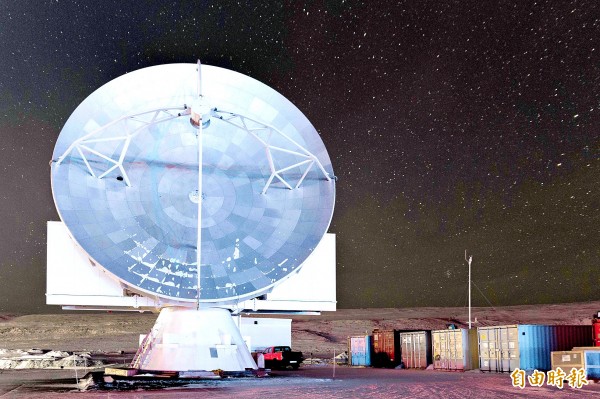《TAIPEI TIMES》 Taiwanese part of black-hole search

The Greenland Telescope at the US’ Thule Air Base in Greenland is pictured beneath the night sky in an undated photograph. Photo courtesy of Academia Sinica
GREENLAND MISSION: Institute of Astronomy and Astrophysics researchers and NCIST engineers helped install a radio telescope at the US’ Thule Air Base
By Lin Chia-nan / Staff reporter
A team of scientists, including researchers from Academia Sinica’s Institute of Astronomy and Astrophysics, have set up a new radio telescope in Greenland and look forward to capturing the world’s first image of a black hole, Taiwanese team members said yesterday.
The institute’s researchers last year worked with colleagues from the Harvard-Smithsonian Center for Astrophysics to install the Greenland Telescope (GLT) at the US’ Thule Air Base, team member Chen Ming-tang (陳明堂) told a news conference in Taipei.
The GLT is the only astronomical observation station in the Arctic Circle, where the drier and clearer weather is conducive for observation, although the minus-30°C temperatures presents many challenges, Chen said.
It is part of the Event Horizon Telescope project, which was designed to capture the image of a black hole by connecting with other telescopes worldwide, including the Submillimeter Array and the James Clerk Maxwell Telescope in Hawaii, and the Atacama Large Millimeter Array in Chile, he said.
Obtaining an image of a black hole would be a significant breakthrough for science, as belief in the existence of black holes rests largely on theoretical inferences and indirect evidence, he said.
More knowledge about black holes would help scientists test Albert Einstein’s theory of general relativity, he added.
Two black holes have been targeted, one in the Messier 87 (M87) galaxy and the other in the center of the Milky Way, where our solar system is located, said Paul Ho (賀曾樸), director-general of the East Asian Observatory in Hawaii and a distinguished research fellow at the institute.
The black hole in M87 is more likely to be observed, given it is more massive, and its rotation slower, Ho said.
The GLT contains a 12m-wide radio antenna originally built as a prototype for the array in Chile, which was granted to the institute by the US National Science Foundation in 2011, Chen said.
In five years, they plan to transport the GLT to the foundation-supported Summit Station where the observational conditions are better, Chen added.
The station is atop a 3,200m peak on the Greenland ice sheet.
The National Chungshan Institute of Science and Technology (NCIST), which has worked with the GLT team since 2011, helped with the engineering needed to adapt the antenna to Arctic weather conditions, Chungshan vice president Ko Ping-ya (葛平亞) told the news conference.
The NCIST team would face further challenges with moving the GLT, since the Summit Station has limited daily provisions, unlike what is available on the air base, Ko said.
新聞來源:TAIPEI TIMES
















